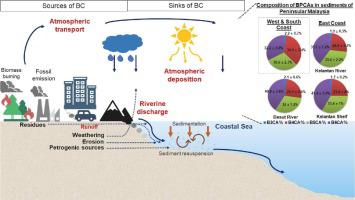Marine Chemistry ( IF 3.0 ) Pub Date : 2021-10-05 , DOI: 10.1016/j.marchem.2021.104032 Vahab Vaezzadeh 1, 2, 3 , Xin Yi 1 , Margaret William Thomes 3, 4 , Chui Wei Bong 3, 5 , Choon Weng Lee 3, 5 , Mohamad Pauzi Zakaria 3 , Ai-Jun Wang 6 , Putri Nadhirah Binti Roslin 3, 4 , Guangcai Zhong 1, 2 , Gan Zhang 1, 2

|
Black carbon (BC) acts as a reservoir of carbon in sediment due to its high persistency. Southeast Asia (SEA) is a main source region for BC emissions across the globe due to extensive biomass burning and escalating fossil fuel consumption. However, our understanding of the sources and sinks of BC in SEA is limited. Here, we have analysed BC structure using benzene polycarboxylic acid (BPCA) method in combination of stable carbon isotope (δ13C) signatures for B5CA and B6CA using HPLC-IRMS in sediment samples from riverine, coastal and shelf areas in Peninsular Malaysia. BPCA molecular markers indicated higher degree of aromatic condensation and lighter isotopic composition in relatively pristine environment of the East coast compared to developed environment of the West and South coast. n-Alkane biomarkers clearly demonstrated higher anthropogenic impacts on the sediments of the West and South coast compared to the East coast. Biomass burning with the predominance of C3 plants and the large share of natural gas in the energy mix in Malaysia are possibly the main reasons for the isotopically light composition of sedimentary BC (−45.4 to −26.4‰). Atmospheric soot and petrogenic BC are the possible main sources of BC in the East coast sediments, while char residues of low temperature biomass burning likely contribute more to sedimentary BC in the West and South coast. The n-alkane indices implied that the sediments of the Kelantan adjacent shelf area receive great proportion of terrestrial organic matter and the associated BC.
中文翻译:

使用分子标记和化合物特异性同位素特征来追踪马来西亚半岛表层沉积物中黑碳的来源:人为活动的影响
黑碳 (BC) 由于其高持久性而充当沉积物中的碳库。由于大量的生物质燃烧和不断增加的化石燃料消耗,东南亚 (SEA) 是全球 BC 排放的主要来源地区。然而,我们对 SEA 中 BC 的源汇的了解是有限的。在这里,我们使用苯多羧酸 (BPCA) 方法结合稳定碳同位素 (δ 13 C) 特征分析了 B5CA 和 B6CA 的 BC 结构,使用 HPLC-IRMS 在马来西亚半岛河流、沿海和陆架地区的沉积物样品中。BPCA 分子标记表明芳香族缩合度更高,同位素组成更轻与西海岸和南海岸的发达环境相比,东海岸的环境相对原始。与东海岸相比,正烷烃生物标志物清楚地表明,西海岸和南海岸的沉积物受到更高的人为影响。以 C 3为主的生物质燃烧植物和马来西亚能源结构中天然气的大部分可能是沉积 BC(-45.4 至 -26.4‰)同位素轻组成的主要原因。大气烟尘和岩源炭黑可能是东海岸沉积物中炭黑的主要来源,而低温生物质燃烧的炭残留物可能对西海岸和南海岸的沉积炭黑贡献更大。正构烷烃指数表明吉兰丹邻近陆架区的沉积物接收了很大比例的陆地有机质和相关的 BC。











































 京公网安备 11010802027423号
京公网安备 11010802027423号